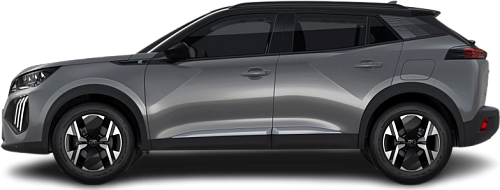USA EV Comparison: Kia Soul EV Standard Range vs Peugeot e-2008 50 kWh
Struggling to Decide? Let AI Help!
Your AI Summary Is Ready!
General Info
While both vehicles are currently in production, they are not sold in the United States.
The two vehicles share the same body style: SUV.
| Property | Kia Soul EV Standard Range | Peugeot e-2008 50 kWh |
|---|---|---|
| Years of Production | 2020-… | 2023-… |
| Current Status | Produced | Produced |
| Country of Manufacture | South Korea | China, Spain |
| Body Style | SUV | SUV |
| Market Availability | EU | EU |
| GCC Score | 5.1 | 5.2 |
Range and Efficiency
The Peugeot e-2008 50 kWh (2023-…) boasts a greater real-world range, a larger battery, and superior energy efficiency compared to the Kia Soul EV Standard Range (2020-…).
| Property | Kia Soul EV Standard Range | Peugeot e-2008 50 kWh |
|---|---|---|
| Range (WLTP) | 171 mi | 211 mi |
| Range (GCC) | 146 mi | 180 mi |
| Battery Capacity (Nominal) | 42 kWh | 50 kWh |
| Battery Capacity (Usable) | 39.2 kWh | 46.3 kWh |
| Efficiency per 100 mi | 26.8 kWh/100 mi | 25.7 kWh/100 mi |
| Efficiency per kWh | 3.72 mi/kWh | 3.89 mi/kWh |
| Range and Efficiency Score | 5.4 | 6.1 |
Charging
Both vehicles utilize a standard 400-volt architecture.
The Peugeot e-2008 50 kWh (2023-…) offers faster charging speeds at DC stations, reaching up to 101 kW, while the Kia Soul EV Standard Range (2020-…) maxes out at 44 kW.
The Peugeot e-2008 50 kWh (2023-…) features a more powerful on-board charger, supporting a maximum AC charging power of 7.4 kW, whereas the Kia Soul EV Standard Range (2020-…) is limited to 7.2 kW.
| Property | Kia Soul EV Standard Range | Peugeot e-2008 50 kWh |
|---|---|---|
| Max Charging Power (AC) | 7.2 kW | 7.4 kW |
| Max Charging Power (DC) | 44 kW | 101 kW |
| Architecture | 400 V | 400 V |
| Charge Port | CCS Type 2 | CCS Type 2 |
| Charging Score | 4 | 4.3 |
Performance
Both vehicles are front-wheel drive.
With equal motor power, both cars deliver the same 0-60 mph acceleration time.
| Property | Kia Soul EV Standard Range | Peugeot e-2008 50 kWh |
|---|---|---|
| Drive Type | FWD | FWD |
| Motor Type | PMSM | PMSM |
| Motor Power (kW) | 100 kW | 100 kW |
| Motor Power (hp) | 134 hp | 134 hp |
| Motor Torque | 291 lb-ft | 192 lb-ft |
| 0-60 mph | 9.5 s | 9.5 s |
| Top Speed | 97 mph | 93 mph |
| Performance Score | 3.1 | 2.7 |
Dimensions
The Peugeot e-2008 50 kWh (2023-…) has a longer body, while the Kia Soul EV Standard Range (2020-…) stands taller, offering a more elevated ride. Their widths are almost identical, so both offer a similar amount of shoulder room.
Both models have similar wheelbase lengths.
| Property | Kia Soul EV Standard Range | Peugeot e-2008 50 kWh |
|---|---|---|
| Length | 165.2 in | 169.4 in |
| Width (with Mirrors) | - Width (with Mirrors) | 78.2 in |
| Width (w/o Mirrors) | 70.9 in | 69.9 in |
| Height | 63.2 in | 60 in |
| Wheelbase | 102.4 in | 102.6 in |
Cargo and Towing
The Peugeot e-2008 50 kWh (2023-…) provides more cargo capacity, featuring both a larger trunk and more space with the rear seats folded.
Neither car is equipped with a frunk (front trunk).
Neither vehicle is officially rated for towing in the US.
| Property | Kia Soul EV Standard Range | Peugeot e-2008 50 kWh |
|---|---|---|
| Number of Seats | 5 | 5 |
| Curb Weight | 3549 lb | 3578 lb |
| Cargo Volume (Trunk) | 11.1 ft3 | 15.3 ft3 |
| Cargo Volume (Max) | 47.3 ft3 | 51.8 ft3 |
| Cargo Volume (Frunk) | - Cargo Volume (Frunk) | - Cargo Volume (Frunk) |
| Towing Capacity | - Towing Capacity | - Towing Capacity |
| Cargo and Towing Score | 5.5 | 5.2 |




